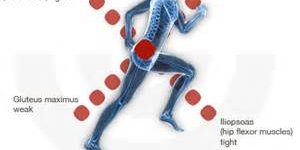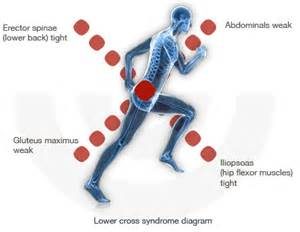What is Lower Crossed Syndrome?
Just like in upper crossed syndrome, lower crossed syndrome is a muscular abnormality of the body brought on by one’s posture. Common patterns of lower crossed syndrome include tight lower back muscles, potentially with lower back pain. The individual might also have sore knees due to tight leg adductor muscles (muscles that move your legs towards the center of your body.
Lower crossed syndrome can develop from someone who sits for long periods of time, leaning in a slightly flexed position. This causes the lower back muscles or erector spinae to continually contract to hold the body’s weight upright while the constantly flexed position shortens the muscle length of the Iliopsoas and Rectus Femoris muscles. Through continued concentric contraction or in a shortened position, the muscles adapt and shorten in length leading to muscle tightness.
However, since the body acts like a series of pulleys and levers, when one muscle gets shortened, it usually means that another muscle gets lengthened. This phenomenon is known as reciprocal inhibition. How it works is that when a muscle is contracting, the muscle opposite of its function, or antagonist muscle, is turned off so that they aren’t both contracting at once. Your brain can of course override this, but the purpose of reciprocal inhibition is to make the body more efficient and to avoid injury. While inhibited though, the antagonist muscle is not only prevented from contracting, but in many cases, is actually stretched or lengthened. If you think of your quads (front thigh muscles) versus your hamstrings (back thigh muscles), if you flex one, you’ll usually feel the other stretch when you maximally stretch (I really feel this if I’m sitting down). In the end, the shortened tight muscles cause the stretching and lengthening of their antagonist muscles. This ultimately leads to the weakening of those muscles.
Due to the tightened and lengthened muscles, one with lower crossed syndrome will typically present with anterior pelvic tilt. This could look like someone is hunching over forward since their feet are more than likely planted on the ground. They might also have an increased lumbar lordotic curve, or increased lower back arch, which contributes to the anterior pelvic tilt. Both conditions help to further enforce the lower crossed syndrome, resulting in one of the many reasons for lower back pain.
You can see the anterior pelvic tilt in this example
Muscles commonly tight or shortened in lower crossed syndrome include:
- Iliopsoas
- Rectus Femoris
- Erector spinae
- Piriformis
- Tensor Fascia Latae (TFL)
- Leg Adductors
The weakened or lengthened muscles include:
- Abdominal group
- Gluteal group


